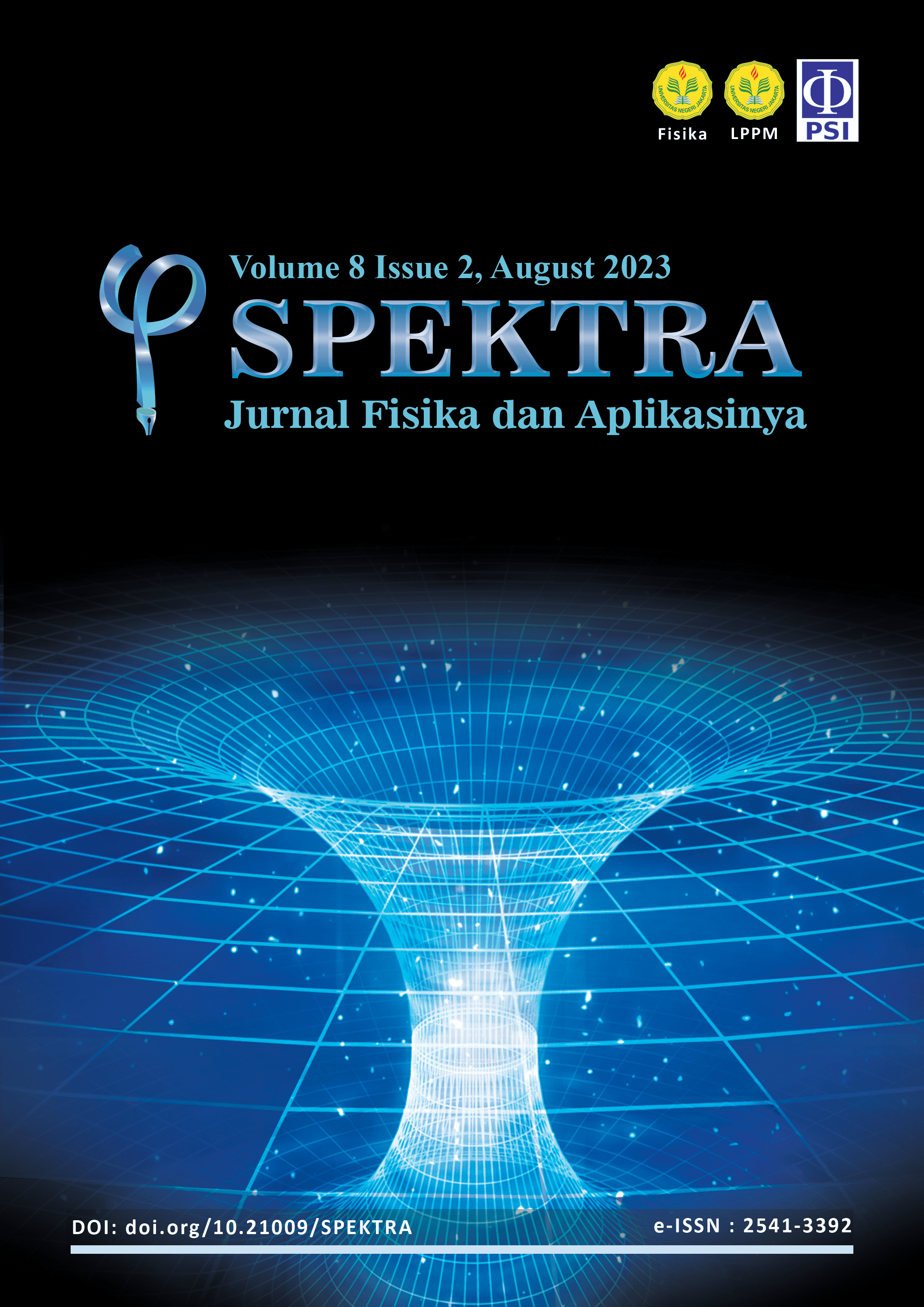THE COMPARISON OF 2D DOSE PATIENT-SPECIFIC QUALITY ASSURANCE BETWEEN MONTE CARLO-CONVOLUTION AND MODIFIED CLARKSON INTEGRATION ALGORITHM
DOI:
https://doi.org/10.21009/SPEKTRA.082.01Keywords:
patient-specific quality assurance, log files, 2D dose calculation algorithmAbstract
A sophisticated machine of radiotherapy treatment process follows the complexity of the quality assurance (QA) measurement. Non-measurement QA becomes one of the solutions to reduce the medical physicists’ workload. However, this method has not been clinically established. This study compared two non-measurement methods of patient-specific quality assurance (PSQA) to find the feasible algorithm for the adaptive radiotherapy process. Monte Carlo-based (MC) PSQA used a phase space file of the medical linear accelerator (Linac) to obtain the photon energy fluence and forward projected to the isoplane. In contrast, Modified Clarkson Integration-based (MCI) used a non-uniform fluence map in the isoplane. For the modulated intensity, we used a pair of the dynamic log files of the multileaf-collimator (MLC) and then employed them in the algorithms. The dose distributions of MC and MCI methods were compared to the treatment planning system (TPS) using gamma index analysis. We found that the gamma pass rates (GPR) for MC-TPS and MCI-TPS were 99.54% and 99.57%, respectively. Further, the dose distribution in the off-axis region for the MCI method showed lesser accuracy due to the higher secondary dose contribution. The linac log file information can be used and calculated into a 2D dose distribution using both MC and MCI methods, providing high-accuracy results.
References
Arikunto, S. (2006). Metode Penelitian Kualitatif. Jakarta: Bumi Aksara.
Badrujaman, A. (2015). Metode Penelitian Lanjutan dalam Bimbingan dan Konseling. Jakarta: Lembaga Pengembangan Pendidikan Universitas Negeri Jakarta.
Bernard, M. E. (Penyunt.). (2013). The Strength of Self-Acceptance Theory, Practice and Research. New York: Springer.
Bernard, M. E. (2013). The Strength of Self-Acceptance: Theory Practice and Research. . London: Springer.
Chase, S. E. (2005). Narrative Inquiry: Multiple Lenses, Approaches, Voices. In I. N. K. Denzin & Y. S. Lincoln (Eds.), The Sage handbook of qualitative research (pp. 651–679). Sage Publications Ltd.
Creswell, J. W. (2007). Qualitative inquiry and research design : Choosing among five approaches. California: Sage Publications, Inc.
Dariyo, A. (2007). Psikologi perkembangan, anak tiga tahun pertama . Bandung: PT. Refina Aditama.
Elliot, G. C. (2009). Family Matters : The Importance of Mattering to Family in Adolescence. West Sussex: Blackwell Publishing.
Germer, C. K. (2009). The Mindful Path To Self-Compassion. United States of America: The Guilford Press.
Gunarsa, S. D., & Gunarsa, Y. S. (2008). Psikologi Perkembangan Anak dan Remaja. Jakarta: PT. BPK Gunung Mulia.
Hurlock, E. B. (2006). Psikologi Perkembangan : suatu pendekatan sepanjang rentang kehidupan. Jakarta: Erlangga.
Krisnani, H., & Farakhiyah , R. (2010). Meningkatkan Kemampuan Pengambilan Keputusan pada Remaja Akhir dengan Menggunakan Metode Reality Therapy. Share: Social Work Jurnal, 29-38.
Lestari, S. (2012). Psikologi Keluarga : Penanaman Nilai dan Penanganan Konflik dalam Keluarga. Jakarta: Kencana .
Machdan, D. M., & Hartini, N. (2012). Hubungan Antara Penerimaan Diri dengan Kecemasan Menghadapi Dunia kerja pada Tunadaksa di UPT Rehabilitasi Sosial Cacat Tubuh Pasuruan. Jurnal Psikologi Klinis dan Kesehatan Mental, 79-85.
Marliani, R. (2016). Psikologi Perkembangan Anak dan Remaja. Bandung: CV Pustaka Setia.
Micucci, J. A. (2009). The adolescent in family therapy : harnessing the power of relationships (2nd ed.). New York: The Guilford Press.
Nasir, B. (2012). Faktor-faktor yang Mempengaruhi Perceraian di Kecamatan Sungai Kunjang Kota Samarinda. Jurnal Psikostudia Universitas Mulawarman, 31-48.
Puspitorini, I. (2019). Stop Perceraian Selamatkan Perkawinan. Temanggung: Desa Pustaka Indonesia.
Polkinghorne, D. E. (1995). Narrative configuration in qualitative analysis. International Journal of Qualitative Studies in Education, 8(1), 5–23. https://doi.org/10.1080/0951839950080103
Simon, T., Nepo, M., Hanson, R., & Neff, K. (2016). The Self-Acceptance Project: How to Be Kind and Compassionate Toward Yourself in Any Situation. Boulder: Soundstrue.
Syaifuddin, M., Turatmiyah, S., & Yahanan, A. (2013). Hukum Perceraian. jakarta Timur: Sinar Grafika.
Verauli, R. (2018). Teenager 911. Jakarta Pusat: KataKita.
Wandberg, R. (2002). Self-Acceptance: building confidence. Mankato, Minnesota: Capstone Press.
Wangge, B. D., & Hartini, N. (2013). Hubungan antara Penerimaan Diri dengan Harga Diri pada Remaja pasca Perceraian Orangtua. Jurnal Psikologi Kepribadian dan Sosial, 1-6.
Downloads
Published
How to Cite
Issue
Section
License
SPEKTRA: Jurnal Fisika dan Aplikasinya allow the author(s) to hold the copyright without restrictions and allow the author(s) to retain publishing rights without restrictions. SPEKTRA: Jurnal Fisika dan Aplikasinya CC-BY or an equivalent license as the optimal license for the publication, distribution, use, and reuse of scholarly work. In developing strategy and setting priorities, SPEKTRA: Jurnal Fisika dan Aplikasinya recognize that free access is better than priced access, libre access is better than free access, and libre under CC-BY or the equivalent is better than libre under more restrictive open licenses. We should achieve what we can when we can. We should not delay achieving free in order to achieve libre, and we should not stop with free when we can achieve libre.
 SPEKTRA: Jurnal Fisika dan Aplikasinya is licensed under a Creative Commons Attribution 4.0 International License.
SPEKTRA: Jurnal Fisika dan Aplikasinya is licensed under a Creative Commons Attribution 4.0 International License.
You are free to:
Share - copy and redistribute the material in any medium or format
Adapt - remix, transform, and build upon the material for any purpose, even commercially.
The licensor cannot revoke these freedoms as long as you follow the license terms.

 E-ISSN 2541-3392
E-ISSN 2541-3392  Focus & Scope
Focus & Scope  Editorial Team
Editorial Team  Reviewer Team
Reviewer Team  Author Guidelines
Author Guidelines  Article Template
Article Template  Author Fee
Author Fee  Publication Ethics
Publication Ethics  Plagiarism Policy
Plagiarism Policy  Open Access Policy
Open Access Policy  Peer Review Process
Peer Review Process  Retraction & Correction
Retraction & Correction  Licensing & Copyright
Licensing & Copyright  Archiving & Repository
Archiving & Repository  Contact
Contact  Mendeley
Mendeley 

